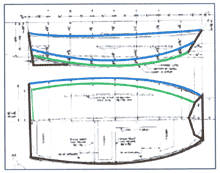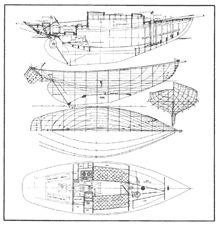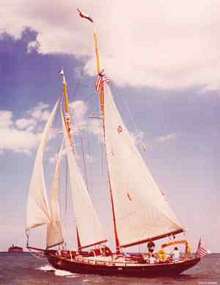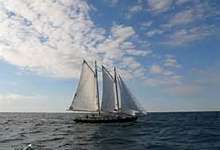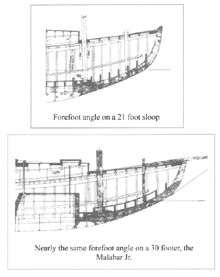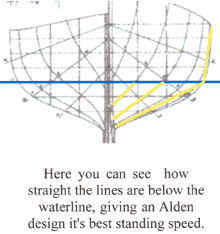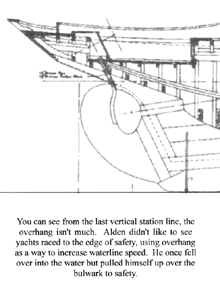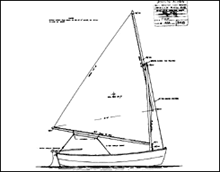
 Custom Search
|
| boat plans |
| canoe/kayak |
| electrical |
| epoxy/supplies |
| fasteners |
| gear |
| gift certificates |
| hardware |
| hatches/deckplates |
| media |
| paint/varnish |
| rope/line |
| rowing/sculling |
| sailmaking |
| sails |
| tools |
| join |
| home |
| indexes |
| classifieds |
| calendar |
| archives |
| about |
| links |
| Join Duckworks Get free newsletter CLICK HERE |
|
|
| Out There |
by Paul Austin - Dallas, Texas - USA DOODLING FAME: John Alden and His Schooners |
 |
Did you ever doodle? Well, the famous schooner designer John Alden started out that way, as a kid. When his family moved to Dorchester MA, he got to see great ships. It's more than coincidence that so many famous ship designers began by watching. They seem to get a proportion of hull to sail in their mind's eyes, and it never leaves. His doodles became famous years later. Nowadays we use computers but the ability to draw well was worth a day's pay when big ships were being built in the 1900s. Bolger was known for the steadiness of his freehand lines, and Alden was probably the same way. He first learned about boats by sitting in his sister's rowboat, lifting an umbrella as a sail. But when he saw the Grand Banks schooners in Dorchester, they took up his life. He looked to sea. If his family was going to tell John to get a real job, his father died when John was 18 years old. So the path was open for him to train as a naval architect. He took courses at MIT, as many other designers did, and then he struck gold. He apprenticed with Starling Burgess and Bowdoin B. Crowninshield. He must've had great talent to be hired with Burgess, who at this time had designed an America's Cup racer. And then in 1907 his life took its' own course. The schooner Fame was owned by a fishing company. Smallpox attacked the crew, so the schooner had to be sailed to Boston by someone else. Alden rounded up 4 rogues and one old salt to sail the ship. The voyage was one of the worst on record. The winter sky hurled 60mph winds that struck the ship like bolts of ice from an angry god. The sails shrieked and tore at their edges, ropes cracked stiff against the bulwarks, ice grew off the rooftops, it was a perfectly terrible voyage. But the rogues, the old salt and Alden stood up to their task. When they docked the schooner in Boston, Alden went inside and for the next few days thought about how to survive at sea. He thought about what kind of ship could withstand winds and winter and forbidding seas leaping up to laugh at a sailor's face. He thought about what it takes to sail short-handed, what it takes for a ship to be stable at sea. What if he hadn't taken the ship out to sea? What if the schooner had leaked, with all hands drowning in the ice-frozen sea? What if Alden had not been up to the tasks of a schooner at sea? And yet, he was up to the winter, up to sailing a schooner, up to analyzing what had gone right. He apprenticed in the design firm of B. B. Crowninshield in Boston from 1904 until 1909. He became familiar with the local shipyards and their techniques, their scantlings and proportions. Now, just before WWI, Alden left Crowninshield to form his own design firm. In these early days, he designed 30-40 footers, yawls and ketches, with a few schooners. When men came back from the war, the yacht clubs offered small contracts for one-design club racers, as clubs competed with clubs for young men with money. The early days of his own design firm were not profitable, with little work for a young unknown man. Those days cost him his marriage. But by 1917 the firm was getting enough work to employ specialist draftsmen. Alden himself must have had some quality of attraction, because the young men he hired often became famous later in their lives, such as Aage Nielson, Charles MacGregor, Murray Peterson and Fenwick Williams. At this time, Alden settled on some of his trademark design features he would be loyal to for the rest of his life. These would be short overhangs, outboard rudders, modest sail plans and watertight bulkheads for the engines. John didn't just start out with schooners. He was comfortable with whatever length and weight the client specified. With his priorities of easy sailing, cruising and racing, and single-handing, he emphasized the deck arrangement, the rigging rather than the sail size, and the stability of the hull. Whereas Herreshoff concerned himself with slender hulls, tall sail areas and outside ballast Alden focused on the ship's interior and its' ease of handling. The 21 foot sloop above is an example. As a double-ender not only is it safe at sea, but the narrow lines of the hull coming off the stem at the waterline allow speed while the wider lines above the waterline make room for 4'2" of headroom in the cabin. Nearly all designers of cruisers less than 30 feet reduce something for the sake of something else. Usually cabin roofs are low for less windage, taking space from below so that headroom on most short cruisers is less than 4 feet. Some designs try to make up for a low roof with a deeper cabin sole by lowering the frame joists, thus requiring the designer to create a deep keel with outside ballast. But outside ballast can make a short boat swerve at anchor and in certain conditions. So what did John do? He blended something of a catboat width and an Archer double-ender. He moved the intersection of the second buttock and frame 3 at the waterline far enough away from the keel to make room for bunks. And with spreading a small percentage of the turn of the bilge just beneath the waterline, John has created the room for sitting near the aft of the cabin, around frame 7. The interior layout looks blandly conventional but it is just right. What we have is a design in three sections: (1) a narrow entrance for the first three frames, (2) a wider living area which sits on the waterline to be stable, and (3) a double-ender stern with a catboat keel and rudder with plenty of wetted surface. The high-peaked gaff rig is simpler but reefs with difficulty, while the marconi rig has several more stays to tame and replace. In a 21 foot round-bilged sloop, this is quite a design. By the way, it was the first set of plans Wooden Boat Magazine published and sold. If you'd like to build this boat, make sure you're good at through-bolting.
By the 1920s, the long fishing schooners were no longer profitable. What replaced them, at least in demand at the yacht design firms, were smaller cruisers, cheaper to build and maintain. John knew the wisdom of ships already built. He knew sometimes a ship which had already proven itself was the best model for a new cruiser. So he gathered up the lines and offsets of catboats and Friendship sloops. These had been fishing boats, but long out of use. John took the basic dimensions and qualities of a Friendship sloop to create a comfortable, swift cruiser he named Malabar Jr. One of his draftsmen was Aage Nielson, who would later become famous in his own right. Nielson drew the sail plan and lazyjacks for all sails. This yawl was 30 feet, with a beam of 9'8". That's nearly a 3-1 ratio of waterline length to beam. He widened the bow so it wouldn't pound at sea, putting the ballast outside. Malabar Jr. was designed in 1926-1928, according to WB Magazine. It wasn't John's first attempt at altering a working boat into a cruiser which could race the ocean, but this yawl would require the least alterations to race. While the keel is deep, it's construction is simple, as Alden keels are. The pieces are few, nearly parallel to the waterline with the engine aft of the ballast. With one mast, there is room for 4 bunks and a generous galley. The plan view lines show the topsides amidships are nearly upright from the waterline to the sheer. This will help Malabar Jr. hold its' course when you've fallen asleep over the wheel. This Malabar Jr. yawl will remind some of the old salts of the Concordia yawls. This is such a handsome cruiser, I'm glad the price for plans are only $150.
Now we come to the schooners for which John is still known today. His goal in these schooners seemed to be that they would be fast and yet dry. The two qualities don't always go together. All the Malabars were drawn with the idea of John sailing them singlehanded. So the deck was arranged to be simple, the cabin was not large or ornate, and the sails had lazyjacks and self-tending sheets. Ordinarily, sails with plenty of rigging get swirling winds but Alden says Malabar II was a fine light air craft. This might be due to the nearly straight first 4 frames in the water and the deadrise angle of most of the frames after them. Alden says Malabar II could beat along to weather on foresail alone, which is a great attribute when you're the captain and you're the crew. The WB study plans shows Alden's design characteristics:
The Malabars were so well designed, in 1923 Malabar IV was the overall winner in the race to Bermuda. Two other Alden schooners won 4th and 5th place. In 1924 the Alden Primrose IV took second place in its' class. In 1926 Malabar VII won first prize overall and Class A winner. Alden schooners took 1st, 2nd and 3rd place that year. And the Malabar wins in ocean racing goes on and on, from 1923 until 1934. John's designs do not look back to the commercial fishing days of 150 foot schooners, nor do they look forward to the 1930s, which would be the mark of Olin Stephens and his yawl, Dorade. John stayed in his own time. This seems to be a trademark of the 1920s. The finest prose writer of the time was P. G. Wodehouse, whose stories remain in the same years long after those years were over. The 1920s were the times of 'savior' figures like Tarzan, Sherlock Holmes, Hercule Poirot and Flash Gordon. It seems people like Alden knew that decade was ending, times were a'changing, and they didn't admire what was happening to the world. They seem to hope to hold on to some quality, some appearance which they found superior to the young speakeasy age of Depression and war which was coming. The 1920s were the great age of designers, tracing the big lessons of great commercial ships into the smaller yachts and personal schooners of the day. Herreshoff was in his prime, Crowninshield was there, William Hand and C. D. Mower. But today it is known as the Age of Alden. Thank you, John. ***** Paul is also publishing his books on Amazon. |
|



